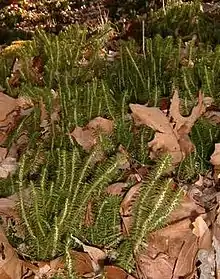Huperzioideae
Huperzioideae is a subfamily of lycopsids in the family Lycopodiaceae. It has sometimes been recognized as a separate family, Huperziaceae. The Pteridophyte Phylogeny Group classification of 2016 (PPG I) recognizes three extant genera:[1]
- Huperzia (temperate firmosses); about 25 species; terrestrial.
- Phlegmariurus (tropical firmosses); about 250 species; previously included in Huperzia; mainly epiphytes.
- Phylloglossum (pygmy clubmoss); formerly thought to be only distantly related to Huperzia. This is a terrestrial, grass-like plant with basal, 2–5 cm long, fleshy leaves. The only accepted species is Phylloglossum drummondii.
| Huperzioideae | |
|---|---|
 | |
| Shining firmoss, Huperzia lucidula | |
| Scientific classification | |
| Kingdom: | Plantae |
| Clade: | Tracheophytes |
| Clade: | Lycophytes |
| Class: | Lycopodiopsida |
| Order: | Lycopodiales |
| Family: | Lycopodiaceae |
| Subfamily: | Huperzioideae W.H.Wagner & Beitel ex B.Øllg.[1] |
| Genera | |
| |
The plants are distinct from those of other members of the Lycopodiaceae in having erect (not creeping) growth; and in their spore-bearing structures being produced in the axils of unmodified leaves, rather than in terminal club-like structures. The subfamily also has a basal chromosome count of n=67, versus counts of n=23, 34 in the Lycopodiaceae.
References
- PPG I (2016). "A community-derived classification for extant lycophytes and ferns". Journal of Systematics and Evolution. 54 (6): 563–603. doi:10.1111/jse.12229.
This article is issued from Wikipedia. The text is licensed under Creative Commons - Attribution - Sharealike. Additional terms may apply for the media files.